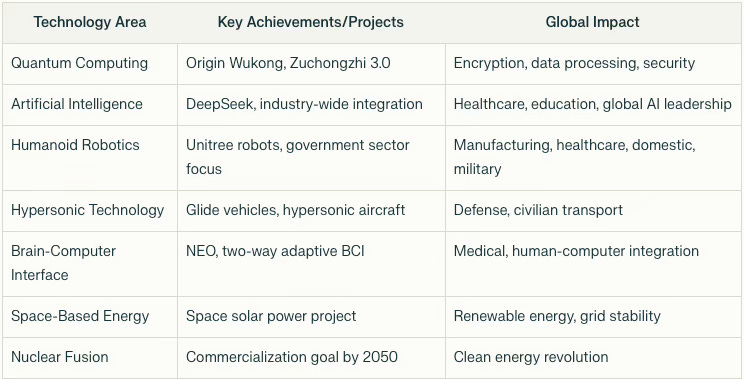Briefing: China's Disruptive Technologies
Strategic Investment and Breakthroughs in AI, Quantum Computing, and Advanced Engineering Could Redefine China’s Role in the World Tech Order
Overview
Through its sweeping technological transformation China channels significant resources into advanced fields including artificial intelligence and quantum computing alongside hypersonic technology, robotics, and green energy development. As a result of aggressive government policies combined with substantial investment and self-sufficiency goals China is experiencing fast technological progress which allows it to exceed Western competitors in key sectors like quantum computing and hypersonic flight. China's technological advancements reinforce its military and economic strength while challenging Western technological supremacy and altering the international power structure.
Strategic Vision and Investment
National Priority: Disruptive technology-defined as innovation that significantly alters established industries and markets-is a core focus for Beijing, with the goal of achieving self-reliance and global leadership in science and technology.
Major Funding: China has established a nearly 1 trillion-yuan tech fund and is set to spend $55 billion on R&D in 2025, targeting areas like AI, semiconductors, and quantum computing.
Policy Framework: Initiatives such as “Made in China 2025” and robust STEM education underpin the push for innovation-driven growth and reduced reliance on foreign technology.
Key Disruptive Technology Areas
Notable Recent Achievements
Quantum Leap: The “Zuchongzhi 3.0” quantum computer marks a new global benchmark, outperforming Google’s latest results by a factor of one million in specific tasks.
Hypersonic Edge: China’s new scramjet engine technology nearly doubles thrust at Mach 6, and innovative cooling systems enable sustained hypersonic flight, surpassing US capabilities in several areas.
AI Integration: AI is now deeply embedded in healthcare (remote monitoring, diagnostics), finance, manufacturing, and smart city infrastructure, with strong government support and regulatory oversight.
Industrial Internet: China’s “new infrastructure” initiative is deploying cloud computing, 5G, and smart city systems at scale, shifting innovation from consumer to industrial applications.
Global and Strategic Implications
Competitive Challenge: China’s advances in quantum computing, hypersonics, and AI directly challenge Western technological leadership and are reshaping global standards and supply chains.
Military and Security: Hypersonic weapons and quantum technologies enhance China’s strategic deterrence and cyber capabilities, with significant implications for global security.
Economic Transformation: The focus on disruptive technologies is driving new growth engines, supporting economic resilience, and positioning China as a dominant player in the Fourth Industrial Revolution.
Future Outlook of China’s Disruptive Technologies
Continued Leadership: China is on track to further strengthen its global position in AI, quantum computing, smart manufacturing, and green energy.
Government Support: Ongoing state investment and policy initiatives like “Made in China 2025” will drive innovation and self-reliance.
Rapid AI Growth: AI adoption is expected to accelerate across healthcare, finance, and industry, fueling economic transformation.
Quantum Ambitions: Major breakthroughs in quantum computing are targeted by 2030, with a focus on practical, scalable applications.
Resilience: Despite global competition and regulatory challenges, China’s large market and innovation ecosystem is expected to sustain its technological momentum.
Summary
The Chinese government supports its disruptive technology ambitions through major state-funded investments and ambitious policy structures aimed at achieving technological independence. The advancement of quantum computing, AI technology, hypersonic capabilities, and green technology is quickly closing the innovation divide with Western nations while establishing new worldwide standards. China's advancements in technology are reshaping its economic strength and military power while redefining global technological dynamics and geopolitical structures.






Thanks for the roundup. Appears Beijing's strategy of leapfrog development ((跨越发
展) is finally bearing fruit across a number of domains. I wrote on the Chinese military's integration of AI and other advanced tech on my Substack, if interested. https://ordersandobservations.substack.com/
I’m so happy that China is leaving - or rather has left - the US in its dust.